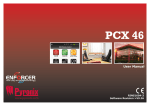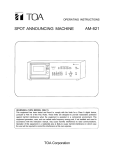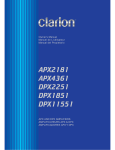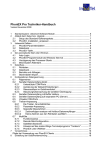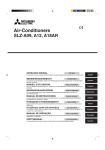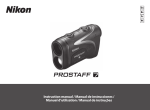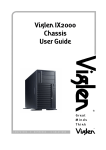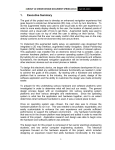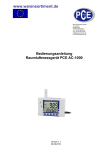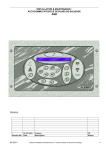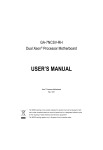Download User Manual - Sussex Alarms
Transcript
2 EN50131-1:2006+A1:2009 EN50131-1 EN50131-3:2009 PD6662:2004 EN50131-6:2008 Security Grade 2 Environmental Class 2 EN50131-5-3:2005+A1:2008 Security Grade 2 Environmental Class II User Manual INTERNAL SIREN WARNING The Enforcer 32-WE control panel contains a 100 dBA siren, please be aware of this when in use. RINS1503-4 Software Revision V9.01 Contents Page A: Introduction B: Keypads / Readers C: Using the Keyfob D: Arming the Enforcer E: Disarming the Enforcer F: Arming / disarming with the tag reader G: Arming / disarming for Entry Control H: Chime Feature I: Personal Attack From Keypad J: Fire Alarm From Keypad K: Master Manager Menu Options 1 Master Manager Menu: Bypass Fire/PA 2 Master Manager Menu: Operate User Automation Outputs 3 Master Manager Menu: Configure Date & Time* 4 Master Manager Menu: Change Codes (Configure user codes, learn tags and keyfobs)* 5 Master Manager Menu: Review Logs (Event memory logs) 6 Master Manager Menu: SMS Phonebook 7 Master Manager Menu: Walk Test 8 Master Manager Menu: Bell Test 9 Master Manager Menu: PC Connect Menu 10 Master Manager Menu: Allow Engineer Menu 11 Master Manager Menu: Block Remote Arm 12 Master Manager Menu: Block UDL 13 Master Manager Menu: Exit Master Menu M: Engineer Contacts and Table N: Input Tables O: User Tables P: Outputs Q: Product Information R: Notes * To quick start the system, only these features are needed to be programmed. 2 3 4 5 6 7 8 8 9 9 9 10 11 11 12 13 16 17 17 17 18 18 19 19 20 21 22 24 25 26 27 A: Introduction Two Way Wireless Security Protect Your Family and Property Without Compromise The Enforcer 32-WE is a wireless alarm system that has been designed with your security in mind; with quick and easy installation and minimal maintenance, the Enforcer 32-WE protects your home with a multitude of unique features. Taking full advantage of Pyronix’s innovative two way wireless technology, the wireless devices on the Enforcer 32-WE system are constantly communicating with each other, using the Pyronix High Security Wireless Encryption Protocol. The Enforcer 32-WE two way wireless devices are fully operational when the system is armed, making your system more secure, compared to other wireless systems, where devices are disabled for up to five minutes after every activation to save battery, therefore compromising your security. The Enforcer 32-WE has been engineered by Pyronix as a secure, reliable and easy to use wireless alarm system. It includes the following features: Battery Monitoring/Saving The Enforcer 32-WE system uses advanced technology to preserve the battery life of each wireless device. However, the Enforcer 32-WE informs you when a battery needs replacing a month in advance before the device stops working. This key feature gives you enough time to change the battery in the specific device. Other wireless alarm systems may not give you a low battery warning signal, meaning that devices could stop working, leaving your environment unprotected. Intelligent Arming This feature enables the control unit to automatically recognise when you’re at home or away and arms itself in the correct mode without you having to choose. User Friendly Keyfobs The fully two way wireless keyfob allows you to see the status of the control unit via 3 colour LEDs: System armed: When the system is armed a RED LED will illuminate momentarily System disarmed: When the system is disarmed a GREEN LED will illuminate momentarily System fault: When the system is in fault condition an AMBER LED will illuminate momentarily, This will also flash when the keyfob is unable to arm the system. It is possible to allocate different functions to each keyfob such as arming / disarming different areas, activating outputs to control external devices such as gates, requesting system status, and activating panic alarms. Up to 32 wireless keyfobs can be added to the Enforcer 32-WE system. Each wireless keyfob has its own user ID which can be reported to the ARC and user mobile phone which are stored into the event log of the control panel individually. The keyfob also allows you to arm/disarm every area individually, giving you total control of your system. User Automation Outputs The Enforcer 32-WE includes user automation outputs that give you the option to operate up to 20 devices such as gates, lights, sprinklers, etc. via your keypad or remotely via your Keyfob, extending the use of your security system. SMS Text Notifications The system will notify you via SMS text messages in real time. For example notification that your child has returned home from school safely or notification of a leakage of water in your property etc. 3 a = Quick exit manager menu. the main keypad, the external tag reader, internal tag reader and the keyfob. CHAPTER 2: KEYPADS / READERS B: Keypads / Readers b = Moves backwards to the previous menu Panel devices Keypad that may be used to arm/disarm the alarm system; these are There are Control four different a = Quick exit manager menu. the main keypad, the external tag reader, internal tag reader and the keyfob. Arming/Disarming Methods: b = Moves backwards to the previous menu There are three different devices that may be used in the process of arming/disarming the alarm item. system; these are theadditional keypad, tag reader and keyfob. c = Enables chime and displays Control Panel Keypad exit manager menu. a = Quick information in the log. Button Operations b = Moves backwards toExit the in previous menu aforward = user menu / be Select D = Moves the log, scrolls between There are four different devices that may usedarea toA.arm/disarm the alarm system; these are item. options and enters the master manager menu. b = Moves backwards to the previous mainand menu / Selects area B. the main keypad, the external tag reader, internal tag reader theitem keyfob. c = Enables chime and displays =toDisplays additional information in the log / Scrolls to previous option in a sub-menu / Selects fp =c Used activateadditional FIRe/PA alarms. information in thearea log. C. [ ] = Directional buttons. D = Moves forward the log, scrolls between Din = Moves forward in the log / Selects area D. t = Selects items and enters menus. C=HUsed AP Tfor ER 2H :and KP EPA Y Palarms. A D2S: K/ ERYEPAADDESR /S R E A D E R S options andKeypad entersf the p master manager menu. Control Panel Fire C A TE R = Quick exit manager menu. a x = Cancels items, and moves to the next f p = Used to activate alarms. buttons (used for choosing options and moving through text). [ ]FIRe/PA = Directional There are four different devices that may be used to arm/disarm the system; these are item in master manager menu There are four different devices. b that be used to alarm arm/disarm the alarm system; these are =may Moves backwards to the previous menu t =the Selects items and enters menus. [ ]the = Directional buttons. main keypad, external tag reader, internal tag reader and the keyfob. the main keypad, the external tag reader, internal tag reader and the keyfob. x = Moves forward in the main menu and sub-menu / Exits option to sub-menu and sub-menu to item. t = Selects items and enters menus. The Internal Tag Reader main menu. Tag Area (Where you present How to navigate through the menu’s. c = Enables chime and displays additional x = Cancels items, and moves to the next your tag to arm/Unset) Control Panel Keypad Control Panel Keypad x = “NO” - Press to move forward when the user mode manager menu. a = Quick exit . item in master manager menu information ina the= Quick log. exit manager menu. b = “BACK” - Press to move backward when in the user mode b = Moves backwards to the previous menu Ready LED b = Moves to the previous menu D = Moves forward in backwards the log, scrolls between The Internal Tag Reader t= “YES” - Press to enter in a submenu or option when in the user mode item. item. Tag Area (Where you present options and chime enters the master manager menu. ] = Press to move from one option into another optionAlarm while in a submenu LED c = Enables displays additional your tag to arm/Unset) c =and Enables chime and displays additional a = Press to quick exit the user menu from any main menu (written in capital letters) information in the log. f p = Used to activate FIRe/PA alarms. information in the log. Tamper LED c = “CANCEL” - Press to move back from one programmable option to the previous option. Ready LED D = Moves forward inMoves the log, scrollsinbetween D = forward the log, scrolls between [ ] and = Directional buttons. Fault LED options enters the master manager menu. manager menu. options and enters the master Alarm Main menus are indicated with capital letters and endLED with a question mark (?), for example “CHANGE CODES?”. The sub-menus are indicated with fp = Used tof activate FIRe/PA alarms. t = Selects items enters menus. p =and Used to activate FIRe/PA alarms. with small LED“Learn codes/tags/keyfobs?”. small letters and they also end with a question mark, forDisarmed example Programmable options are indicated Tamper LED [ ] = Directional buttons. letters and do not finish with question mark (?) but Yes/No or other options are offered. [ ] = Directional buttons. x = Cancels items, and moves to the next t = Selects items and entersitems menus. Fault LED = Selects and enters menus. . item in mastert manager menu The External Tag Reader In order to navigate in the menu system one has to answer to the questions in thex main and sub menus. For example, if the question is “CHANGE = Cancels items, and moves to the next x = Cancels items, and moves to the next LED“Learn codes/tags/keyfobs?”. CODES”. Pressing t ‘YES’ will bring you in the Disarmed sub-menu Pressing t (YES) will take you. to the programmable item in master manager menu . item in master manager menu CHAPTER 2: item. KEY P A D=SEnables / R E A Dchime E R S and displays additional c information in the log. D = Moves forward in the log, scrolls betwee options and enters the master manager menu. f p = Used to activate FIRe/PA alarms. [ ] = Directional buttons. t = Selects items and enters menus. x = Cancels items, and moves to the next . item in master manager menu The Internal Tag Reader Tag Area (Where you present The Internal Reader options of this submenu. Pressing x ‘NO’ Tag will take you out of the individual option, will move you up from one sub-menu next sub-menu or your tag toto the arm/Unset) Tag Area (Where you present back to the main menu. The External Tag Reader The Internal TagThe Reader Internal Tag Reader LEFT GREEN LED: Status indicator (extinguishes after a couple of seconds) REDLED: LED: This can be programmed by your LEFT GREEN engineer to illuminate when the alarm has After a valid tagLED: is Status indicator LEFT GREEN activated for example. presented, the GREEN (extinguishes after a couple of seconds) LED will illuminate RED LED: This can be programmed by your indicating the power engineer to illuminate when the alarm has status. activated for example. Tagyour Area (Where you present tag toTag arm/Unset) Area (Where you present Tagyour Area you tag present your tag to arm/disarm) tag(Where to arm/Unset) your to arm/Unset) Ready LED Ready LED to arm) Ready LED(Ready Ready LED Ready LED Alarm LED LEDAlarm LED Alarm Alarm LED (Shows alarms) Alarm LED Tamper LED Tamper LED Tamper LED Tamper LED (Shows tamper alarms) Fault LED Fault LED Tamper LED Disarmed LED Alert/Pending (Fault) LED (Shows system faults) Fault LED Disarmed LED Disarm LED (Shows Disarmed LEDsystem disarmed) 4 The External Tag Reader The External Tag Reader The External Tag Reader Fault LED ge: 8 C: Using the Keyfob The wireless keyfob has four buttons that may be programmed for specific functions: no action, show status, arm area, disarm area, latch output, timed output and PA alarm activation. Locking the Keyfob All four buttons on the keyfob may be ‘locked’ to prevent from a user accidentally pressing them. Locking the keys on the key-fob is performed by pressing any buttons that are diagonal with one another at the same time (LOCK & II or UNLOCK & I). The RED LED will flash indicating that the fob has been locked. To unlock, press both buttons together again and the GREEN LED will flash indicating that the key-fob is now unlocked. NOTE: When the keyfob is locked, all indications are also disabled. Buttons The buttons can be customised to operate as desired (programmed in the function ‘Change Codes’). Below are examples on how each button can be programmed: BUTTON = Programmed for ‘Arm Area’ When pressed, one or more areas will be armed BUTTON = Programmed for ‘Disarm Area’. When pressed, one or more areas will disarmed. I BUTTON = Programmed for ‘Latch Output’. For example when pressed, a gate can be opened. When pressed again, a gate can be closed. II BUTTON = Programmed for ‘‘Status LED’. For example when pressed, the system status is shown’ RED = Armed, GREEN = Disarmed, ORANGE = Fault. Quick Arming If one of the buttons is programmed as ‘Arm Area’, the alarm system can be armed by the keyfob. The keypad will then start to count down the exit time (depending what the exit mode is programmed by the engineer). Once the alarm panel is in this ‘arming’ stage, it is possible to ‘quick arm’ the system by pressing the same button again; this will reduce the time of arming and therefore making the system arm immediately. The disarm LED on the keypad will turn off and a beep will be heard once the system has been armed and the RED LED on the keyfob will be illuminated for a short time. NOTE: Quick arming cannot be used when ‘intelligent arming’ is enabled. 5 D: Arming the Enforcer ] 9 2 0 [ Deselect the Area's not needed to be armed t A a e r A s s e l e r i W g n i m r A t g n i m r A t i a W e s a e l P ] * * * * * * [ c 3 5 : 2 0 e m i T t ] D C B A s [ a e r A m r A e d o C r u o Y r e t n E E W 2 3 r e c r o f n E User Code User Code ] * * * * * * ? [ g n i m r A p o t S ] D C B A ? [ g n i m r A p o t S t CHAPTER 5: SETTING THE ALARM (CODE/TAG) 1 6 Enter your code 2 Present your tag 3 Use keyfob E: Disarming the Enforcer E W 2 3 r e c r o f n E c t 3 5 : 2 0 e m i T ] * * * * * * [ A a e r A m r A t ] D C s B a A e [ r A m r a s i D e d o C r u o Y r e t n E E W 2 3 r e c r o f n E User Code Deselect the Area's to be disarmed CHAPTER 5: SETTING THE ALARM (CODE/TAG) 1 Enter your code 2 Present your tag 3 Use keyfob 7 F: Arming / disarming with the tag reader If you have a tag reader installed, then it will be possible to arm and disarm the alarm system using a tag. Disarmed Armed Disarmed Armed G: Open doors / Arm and Disarm (Entry Control) A tag reader can also be used to unlock entry doors. Disarmed Locked Armed Disarmed Locked Armed Arming: Present a valid tag to the reader, the GREEN LED will illuminate on the external reader, remove the tag, the door will unlock, then present the same tag wihthin 10 seconds and the system will arm and the door will lock. Disarming: Present a valid tag to the reader and then remove it, the status will be shown (the alarm symbol will illuminate indicating the system is armed onthe internal reader and the RED LED on the external reader), present the same tag wihthin 10 seconds again and the system will be disarmed, and the door will unlock. Access Control: The readers can be used also for opening doors only without the ability to arm and disarm. Please contact your installer for more information on this feature. 8 2 Omitting Inputs H: Chime Feature I: Personal Attack From Keypad J: Fire Alarm From Keypad The chime feature can be used on door contacts to enable a ‘chime’ sound when a door (input) is opened. This feature can be set up by your installer. If an PA alarm is needed, press and hold both the 1 and 7 keys or hold p for 3 seconds and a ‘PA’ alarm will be generated. To disable the chime on the keypad, close all doors and when ‘c’ is displayed, press the c key, a capital ‘C’ will be displayed, this will then activate the chime on any additional keypads with extension speakers installed. If you wish to disable the chime altogether press the c key again. Note: The PA facility needs to be enabled by your engineer (either silent or full alarm) If a fire alarm is needed, press and hold f for 3 seconds and a ‘fire’ alarm will be generated. Note: The Fire alarm key need to be enabled by your engineer. Please note that the key-fob can also be programmed to support a PA alarm. Please discuss this with your engineer. NOTE: Chime should not be used on motion detectors as this will drain the battery. 3 Keypad Hold Up VA N Cemergency E D F U alarm N C TisI Oneeded, N S press If an and hold both the 1 and 7 keys. A ‘hold up’ alarm will be generated. CHAPTER 12: ADVANC 12.1 Chime Feature Note: The Hold Up facility needs to be enabled by your engineer (either silent or full alarm) 2-Key HU and any duress codes programmed on the system by your engineer are not permitted to send a signal to the Alarm Receiving Centre under police regulations in England, Wales or Northern Ireland Please note that the key-fob can also be programmed to support a hold up alarm. Please discuss this with your engineer. 12.2 Omitting Inputs 9 K: Master Manager Menu Options Bypass Inputs Disables any sensor (input) on the system for the current arming period. This feature also disables tamper alarms. Operate User Outputs Activates/deactivates user automation outputs that are used to activate remotely the devices such as electronic gates, lights etc. *Date & Time Programmes the date and time and enables the summertime automatic adjustment. *Change Codes Programmes the user codes, tags and learns keyfobs to the Enforcer 32-WE. Review Log The ‘Review Logs’ function is used to view all operational information of the alarm system, such as arming/disarming information, access control and alarm activations etc. SMS Phonebook If SMS texting is enabled, there will be up to 4 mobile numbers that can be programmed to send SMS alarms. Please discuss this feature with your installer if required. Walk Test The ‘Walk Test’ function allows the testing of all programmed inputs on the alarm system. Bell Test This function is used to tests the external siren (wired and wireless) and strobe. PC Connect Menu The control panel may be dialled into, and programming information kept on a PC using the InSite UDL software. This function allows the control panel to dial a Pre-programmed PC telephone number (programmed by your engineer). This is usually used by your engineer during a maintenance call. Allow Engineer Menu If this function is enabled, the engineer will require authorisation from you before they can access the engineer menu. Block Remote Arming Blocks any attempt at arming the system remotely via the upload/download software Block UDL Blocks any attempt at dialling into the system remotely via the upload/download software Exit Manager Mode Exits the Manager Mode NOTE: Pressing the A key will exit the master manager menu at any main menu option above. *These features are needed to quickly set up the Enforcer. NOTE: Make sure you change the default master user code. 10 L: Entering the Master Manager Menu ? S T U P N I S S A P Y B ] * * * * [ c 3 5 : 2 0 e m i T ] [ t u p n I s s a p y B ] [ t u p n I s s a p y B ? S T U P N I S S A P Y B 1 0 t u p n I : t u p n I n a e s o o h C 6 6 o t 1 0 R E S U E T A R E P O ? S T U P T U O n O t u p t u O f f O t u p t u O t u p t u O t c e l e S R E S U E T A R E P O t t ] 1 0 [ t ? S T U P T U O t x x x f f O / n O t u p u O n r u T x x x x e d o C r e t n E E W 2 3 r e c r o f n E b t t Default Master User Code: 1234 d 1 Master Manager Menu: Bypass Fire/PA 2 Master Manager Menu: Operate User Automation Outputs s u t a t S t u p u O t n e r r u C w o h S : t u p t u O n o i t a m o t u A r e s U t c e l e S 9 1 1 t t u u p p t t u u O O ] ] 1 9 0 - [ 1 [ ? E M I T & E T A D b 11 3 Master Manager Menu: Configure Date & Time* ] 1 3 9 [ 5 0 s e t u n i M 3 2 0 s r u o H 1 3 1 y a D 2 1 1 h t n o M ] 3 2 [ ] 1 0 [ ] 1 0 [ ] 7 0 [ ] 0 [ o N : s n o i t p O o N ] 0 [ s e Y ] 1 [ 12 9 9 0 0 ? j d A e m i T r e m m u S ? S E D O C E G N A H C b r a e Y ? E M I T & E T A D x t x x x x x x t ) ( t ) ( t ) ( t ) ( t ) ( t 4 Master Manager Menu: Change Codes (Configure user codes, learn tags and keyfobs)* e d o c E T E L E D ] D C B a A e [ r A n I r e s U e p y T r e s U ] 0 [ r e s U e ] d o C [ r e s U r e t n E ] 1 0 [ y t p m E ? s b o f y e K n r a e L : e p y T r e s U r e s U ] 0 [ r e g a n a M ] 1 [ e m a N r e s U ] 0 e [ c i o h C m r A a e o r A N s n o i t p O m r A r e s U ] 0 [ m r A / m r a s i D : e c i o h C m r A a e r A : s n o i t p O m r A r e s U o N ] 0 [ m r A / m r a s i D ] 0 [ s e Y ] 1 [ y l n O m r a s i D ] 1 [ y l n O m r A ] 2 [ e n o N ] 3 [ ] 0 e [ c i o h C m r A a e o r A N s n o i t p O m r A r e s U ] 0 [ m r A / m r a s i D ] D C B a A e [ r A n I r e s U r e g a n a M r e t s a M r e t s a M e g n a h C ] * * * * * * [ e d o C ? e d o C r e g a n a M : e c i o h C m r A a e r A x : s n o i t p O m r A r e s U y l n O m r A ] 2 [ s e Y ] 1 [ y l n O m r a s i D ] 1 [ o N ] 0 [ m r A / m r a s i D ] 0 [ x x x x e n o N ] 3 [ e m a N r e s U t _ t t t t t x x x t _ t t ? G O L W E I V E R x b / s g a T / s e d o C r e s U ? S E D O C E G N A H C x x x x x x t t t t t t o t y e K C s s e r P 4.1 Change Codes: Configure User Codes 13 4.2 Change Codes (configure proximity tags) o t y e K C s s e r P g a t E T E L E D ] 2 [ r e s U : e p y T r e s U r e s U ] 0 [ r e g a n a M ] 1 [ g a t t n e s e r P e m a N r e s U e c i o h C m r A a e r A s n o i t p O m r A r e s U ] 0 [ o N ] 0 [ m r A / m r a s i D x x x t _ t t x x x ] D C B a A e [ r A n I r e s U e p y T r e s U e ] d o C [ r e s U r e t n E ] 1 0 [ ? s b o f y e K n r a e L : s n o i t p O m r A r e s U : e c i o h C m r A a e r A m r A / m r a s i D ] 0 [ o N ] 0 [ y l n O m r a s i D ] 1 [ s e Y ] 1 [ y l n O m r A ] 2 [ e n o N ] 3 [ 14 y t p m E / s g a T / s e d o C r e s U x t t t t 4.3 Change Codes (learn/configure keyfobs) o t y e K C s s e r P n o t t u b Y N A d l o H d n a s s e r P ] e d o C [ r e s U r e t n E h s a l f s D E L l i t n u s d n o c e s 5 r o f e m a N r e s U e d o c E T E L E D ] 1 0 [ y t p m E / s g a T / s e d o C r e s U ? s b o f y e K n r a e L ] t u p t u O ] 1 0 [ 0 1 1 t u p t u O b o f y e K ] 9 7 0 7 [ e m i T n e p O t u p t u O K C O L N U n o t t u B ] 2 [ s d n o c e s 0 5 2 0 I I n o t t u B ] 4 [ ] 0 3 0 [ I n o t t u B ] 3 [ t u p t u O d e m i T ] 5 [ e m i T n e p O t u p t u O t u p t u O h c t a L ] 4 [ t u p t u O a e r A m r a s i D ] 3 [ A a [ e r A n I r e s U a e r A m r A ] 2 [ t u p t u O d e m i T f I s u t a t S w o h S ] 1 [ t u p t u O h c t a L f I n o i t c A o N ] 0 [ a e r A m r a s i D r o : n o i t c A n o t t u B K C O L n o t t u B ] 1 [ a e r A m r A f I ] 1 [ n o t t u B : n o t t u B t c e l e S s u t a t S w o h S x ] 1 [ n o i t c A n o t t u B n o t t u B t c e l e S t t _ t t x K C O L N U + K C O L s n o t t u B ] 5 [ I I + I s n o t t u B ] 6 [ I + K C O L s n o t t u B ] 7 [ I I + K C O L N U s n o t t u B ] 8 [ 15 5 Master Manager Menu: Review Logs (Event memory logs) s t n e v E d e c n e l i S m r a l A t 1 0 r e s U : t n e v e e h t n o n o i t a m r o f n i e r o m n i a t b o o T s s e r P g o L f o t r a t S l l a r o f t a e p e R 4 4 : 1 1 : 0 0 1 0 / 1 0 s t n e v E r o o D n e p o r e s U t 1 0 r e s U : t n e v e e h t n o n o i t a m r o f n i e r o m n i a t b o o T s s e r P c t t g o L f o t r a t S l l a r o f t a e p e R 4 4 : 1 1 : 0 0 1 0 / 1 0 ? g o L l r t C / s s e c c A ? K O O B E N O H P S M S 16 ? g o L l e n a P ? S G O L W E I V E R b x x c x x x c x x t t t t c 6 Master Manager Menu: SMS Phonebook e l i b o M r e s U r e b m u N S M S ? K O O B E N O H P S M S e s u t o n o D ] 1 [ t t x x t x ? T S E T K L A W NOTE: Number 1 is normally reserved for ARC communications. Numbers 2,3,4 is normally reserved for SMS messaging. b Before you change this function, please consult your installer. 7 Master Manager Menu: Walk Test s t u p n I t s e T k l a W s a e r A t s e T k l a W ? T S E T K L A W t 1 0 t u p n I ] D C B A [ t x x ] 1 0 t [ u p n I t s e T k l a W x t t ? T S E T L L E B b 8 Master Manager Menu: Bell Test . . . l l e B g n i t s e T ? T S E T L L E B t x t x ? U N E M T C E N N O C C P b 17 9 Master Manager Menu: PC Connect Menu ] 0 [ C P o t t c e n n o C : n o i t a r e p O t c e l e S C P o t t c e n n o C ] 0 [ 2 m e d o M C P ] 2 [ l a i D t s e T ] 1 [ 3 m e d o M C P ] 3 [ e c i v r e S M R ] 2 [ 4 m e d o M C P ] 4 [ C P m o r f a t a D ] 3 [ C P o t a t a D ] 4 [ s c i t s o n g a i D ] 5 [ g n i n o i s s i m m o C ] 6 [ 10 Master Manager Menu: Allow Engineer Menu C P e t o m e R g n i l l a C n o i t a r e p O t c e l e S 1 m e d o M C P ] 1 [ ? u n e M r g n E w o l l A ? U N E M R G N E W O L L A ] 1 [ s e Y E T O M E R K C O L B ? G N I M R A 18 : l a i D o t C P t c e l e S ? U N E M R G N E W O L L A b x x t t ] 1 [ o t C P t c e l l a e i S d ? U N E M T C E N N O C C P b x x x x t t t t 11 Master Manager Menu: Block Remote Arm ? m r A e t o m e R k c o l B E T O M E R K C O L B ] 0 [ o N ? G N I M R A : m r A e t o m e R k c o l B o N ] 0 [ s e Y ] 1 [ ? L D U K C O L B ] 0 [ ? L D U k c o o l N B ? L D U K C O L B R E G A N A M T I X E ? E D O M b t t Block UDL: [0] No [1] Yes x x x x t t b 12 Master Manager Menu: Block UDL 19 13 Master Manager Menu: Exit Master Menu c 5 2 : 0 e m i T s r e e n i g n E t i x e o t y e k A e h t s s e r P m e t i u n e m n i a m y n a m o r f e d o m R O s r e t t e l l a t i p a c n i d e y a l p s i d ) ( E W 2 3 r e c r o f n E ? S T U P N I S S A P Y B c 5 2 : 0 e m i T ? E D O M 20 BYPASS INPUTS? b E W 2 3 r e c r o f n E S R E E N I G N E T I X E x a t M: Engineer Contacts and Table Alarm Company Date of Installation Site Reference Engineer Name Engineer Contact Number Installed to Grade 2? Yes / No Environmental Class II Other Comments 21 N: Input Tables Wireless Inputs 1 2 3 4 5 6 7 8 9 10 11 12 13 14 15 16 17 18 19 20 21 22 23 24 25 26 27 28 29 30 31 32 22 Input Name Input Areas Description N: Input Tables Wired Inputs Input Name Input Areas Description 33 (RIX2) 34 (RIX2) 35 (RIX Address 0) 36 (RIX Address 0) 37 (RIX Address 0) 38 (RIX Address 0) 39 (RIX Address 0) 40 (RIX Address 0) 41 (RIX Address 0) 42 (RIX Address 0) 43 (RIX Address 1) 44 (RIX Address 1) 45 (RIX Address 1) 46 (RIX Address 1) 47 (RIX Address 1) 48 (RIX Address 1) 49 (RIX Address 1) 50 (RIX Address 1) 51 (RIX Address 2) 52 (RIX Address 2) 53 (RIX Address 2) 54 (RIX Address 2) 55 (RIX Address 2) 56 (RIX Address 2) 57 (RIX Address 2) 58 (RIX Address 2) 59 (RIX Address 3) 60 (RIX Address 3) 61 (RIX Address 3) 62 (RIX Address 3) 63 (RIX Address 3) 64 (RIX Address 3) 65 (RIX Address 3) 66 (RIX Address 3) 23 O: User Tables User Name Code/Tag/Keyfob User Name Code/Tag/Keyfob User 1 33 65 2 34 66 3 35 67 4 36 68 5 37 69 6 38 70 7 39 71 8 40 72 9 41 73 10 42 74 11 43 75 17 49 18 50 19 51 20 52 21 53 22 54 23 55 24 56 25 57 26 58 27 59 28 60 29 61 30 62 31 63 32 64 24 Name Code/Tag/Keyfob P: Outputs Wired Outputs Latched / Timed Type Action Latched / Timed Type Action PGM1 (Onboard) STRB (Onboard) BELL (Onboard) PGM1 (ROX) PGM2 (ROX) PGM3 (ROX) PGM4 (ROX) PGM5 (ROX) PGM6 (ROX) PGM7 (ROX) PGM8 (ROX) PGM9 (ROX) PGM10 (ROX) PGM11 (ROX) PGM12 (ROX) PGM13 (ROX) PGM14 (ROX) PGM15 (ROX) PGM16 (ROX) Wireless Outputs BELL 1 STRB 1 BELL 2 STRB 2 25 Q: Product Information For electrical products sold within the European Community. At the end of the electrical products useful life, it should not be disposed of with household waste. Please recycle where facilities exist. Check with your Local Authority or retailer for recycling advice in your country. When disposing of the product and accessories, the batteries must be removed and disposed of separately in accordance with the local regulations. 26 R: Notes 27 Website: www.pyronix.com





























